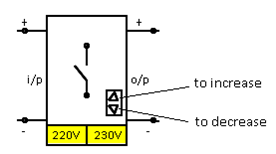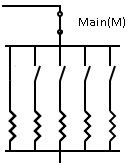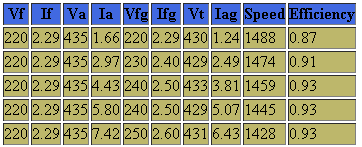Load Test On Seperately Excited DC Motor
Procedure
- Close the DPST (Double Pole Single Throw) switch connecting supply to field winding of the Separately Excited DC motor.
- Increase the Separately Excited DC motor field voltage to rated value (220V).
- Use variable voltage device to increase or decrease the supply

- Close the DPST switch connecting supply to armature winding of the Separately Excited DC motor.
- Increase the motor armature voltage to rated value (440V).
- As Separately Excited DC motor is connected mechanically to Separately Excited DC generator, So both machines rotate with same speed. Therefore we can observe speed of generator in digital tachometer.

- Now increase the excitation of separately excited generator such that o/p of generator will be equal to rated value(220V).
- Now connect the load by closing the switch as shown in the figure

- Note the decrease in voltage of generator and increase in current of generator.As the load goes on increasing speed and armature voltage of the generator decreases.
- Store this data by clicking "Start Storing Data"
- So to keep the voltage of generator constant at load condition adjust the field excitation of generator.
- Now again increase the load by closing another load switch.
- Store this data by clicking "Start Storing Data"
- Go on repeating this procedure till all loads are connected and data is stored.
- Now display the data by clicking "Show data". For Ex

- Vf=field voltage of DC motor
- If=field current of DC motor
- Va=armature voltage of DC motor
- Ia= armature current of DC motor
- Vfg= field voltage of generator
- Ifg=field current of generator
- Vt=terminal voltage
- Iag=armature current of generator
- Now select one of the graphs from available graphs and use "Generate graph" to plot the graph.For Ex
- While switching off, reduce the generator excitation to some lower value and then remove the electrical load of generator.
- Make motor excitation equal to zero and then reduce motor armature voltage to zero.
- Speed of motor goes on decreasing and eventually becomes zero, then remove field excitation of motor.
